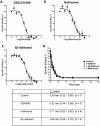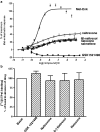The opioid receptor pharmacology of GSK1521498 compared to other ligands with differential effects on compulsive reward-related behaviours
- PMID: 24973897
- PMCID: PMC4281354
- DOI: 10.1007/s00213-014-3666-3
The opioid receptor pharmacology of GSK1521498 compared to other ligands with differential effects on compulsive reward-related behaviours
Abstract
Rationale: The novel opioid receptor antagonist, GSK1421498, has been shown to attenuate reward-driven compulsive behaviours, such as stimulant drug seeking or binge eating, in animals and humans. Here, we report new data on the receptor pharmacology of GSK121498, in comparison to naltrexone, naloxone, 6-β-naltrexol and nalmefene.
Objectives: To determine whether the novel opioid antagonist, GSK1521498, is an orthosteric or allosteric antagonist at the μ opioid receptor (MOPr) and whether it has neutral antagonist or inverse agonist properties.
Methods: A combination of radioligand binding assays and [(35)S]GTPγS binding assays was employed.
Results: GSK1521498 completely displaced [(3)H]naloxone binding to MOPr and did not alter the rate of [(3)H]naloxone dissociation from MOPr observations compatible with it binding to the orthosteric site on MOPr. GSK1521498 exhibited inverse agonism when MOPr was overexpressed but not when the level of MOPr expression was low. In parallel studies under conditions of high receptor expression density, naloxone, naltrexone, 6-β-naltrexol and nalmefene exhibited partial agonism, not inverse agonism as has been reported previously for naloxone and naltrexone. In brain tissue from mice receiving a prolonged morphine pre-treatment, GSK1521498 exhibited slight inverse agonism.
Conclusions: Differences between GSK1521498 and naltrexone in their effects on compulsive reward seeking are arguably linked to the more selective and complete MOPr antagonism of GSK1521498 versus the partial MOPr agonism of naltrexone. GSK1521498 is also pharmacologically differentiated by its inverse agonist efficacy at high levels of MOPr expression, but this may be less likely to contribute to behavioural differentiation at patho-physiological levels of expression.
Figures




Comment in
-
Response to paper by Kelly et al "The opioid receptor pharmacology of GSK1521498 compared to other ligands with different effects on compulsive reward-related behaviors" published in Psychopharmacology 232, 305-314, 2014.Psychopharmacology (Berl). 2015 Apr;232(8):1493-4. doi: 10.1007/s00213-015-3892-3. Epub 2015 Mar 6. Psychopharmacology (Berl). 2015. PMID: 25740344 No abstract available.
-
Reply to Wang and Sadée.Psychopharmacology (Berl). 2015 Apr;232(8):1495-6. doi: 10.1007/s00213-015-3900-7. Epub 2015 Mar 11. Psychopharmacology (Berl). 2015. PMID: 25757674 No abstract available.
Similar articles
-
Inverse agonists and neutral antagonists at mu opioid receptor (MOR): possible role of basal receptor signaling in narcotic dependence.J Neurochem. 2001 Jun;77(6):1590-600. doi: 10.1046/j.1471-4159.2001.00362.x. J Neurochem. 2001. PMID: 11413242
-
In vivo characterization of 6beta-naltrexol, an opioid ligand with less inverse agonist activity compared with naltrexone and naloxone in opioid-dependent mice.J Pharmacol Exp Ther. 2005 Jun;313(3):1150-62. doi: 10.1124/jpet.104.082966. Epub 2005 Feb 16. J Pharmacol Exp Ther. 2005. PMID: 15716384
-
Inhibition of opioid transmission at the μ-opioid receptor prevents both food seeking and binge-like eating.Neuropsychopharmacology. 2012 Nov;37(12):2643-52. doi: 10.1038/npp.2012.128. Epub 2012 Jul 18. Neuropsychopharmacology. 2012. PMID: 22805601 Free PMC article.
-
Ligand-Free Signaling of G-Protein-Coupled Receptors: Relevance to μ Opioid Receptors in Analgesia and Addiction.Molecules. 2022 Sep 8;27(18):5826. doi: 10.3390/molecules27185826. Molecules. 2022. PMID: 36144565 Free PMC article. Review.
-
Critical Assessment of G Protein-Biased Agonism at the μ-Opioid Receptor.Trends Pharmacol Sci. 2020 Dec;41(12):947-959. doi: 10.1016/j.tips.2020.09.009. Epub 2020 Oct 20. Trends Pharmacol Sci. 2020. PMID: 33097283 Review.
Cited by
-
Obesity: Current and potential pharmacotherapeutics and targets.Pharmacol Ther. 2017 Feb;170:116-147. doi: 10.1016/j.pharmthera.2016.10.015. Epub 2016 Oct 20. Pharmacol Ther. 2017. PMID: 27773782 Free PMC article. Review.
-
Response to paper by Kelly et al "The opioid receptor pharmacology of GSK1521498 compared to other ligands with different effects on compulsive reward-related behaviors" published in Psychopharmacology 232, 305-314, 2014.Psychopharmacology (Berl). 2015 Apr;232(8):1493-4. doi: 10.1007/s00213-015-3892-3. Epub 2015 Mar 6. Psychopharmacology (Berl). 2015. PMID: 25740344 No abstract available.
-
Antidepressant-like effects of BU10119, a novel buprenorphine analogue with mixed κ/μ receptor antagonist properties, in mice.Br J Pharmacol. 2018 Jul;175(14):2869-2880. doi: 10.1111/bph.14060. Epub 2017 Nov 6. Br J Pharmacol. 2018. PMID: 28967123 Free PMC article.
-
Reply to Wang and Sadée.Psychopharmacology (Berl). 2015 Apr;232(8):1495-6. doi: 10.1007/s00213-015-3900-7. Epub 2015 Mar 11. Psychopharmacology (Berl). 2015. PMID: 25757674 No abstract available.
-
Evidence for a Long-Lasting Compulsive Alcohol Seeking Phenotype in Rats.Neuropsychopharmacology. 2018 Mar;43(4):728-738. doi: 10.1038/npp.2017.105. Epub 2017 May 29. Neuropsychopharmacology. 2018. PMID: 28553834 Free PMC article.
References
-
- Bourassa P, Bagheri H, Pineyro G, Grandbois M, Gendron L (2014) Label-free monitoring of μ opioid receptor-mediated signaling. Mol Pharmacol - PubMed
Publication types
MeSH terms
Substances
Grants and funding
LinkOut - more resources
Full Text Sources
Other Literature Sources
Molecular Biology Databases
Research Materials

